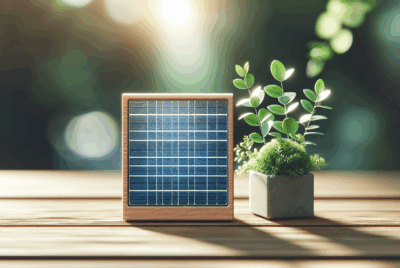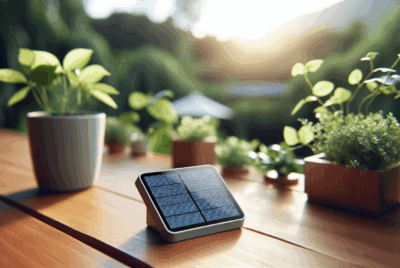Solar Fan: Your Ultimate Guide to Harnessing Solar Power
As an Amazon Associate, I earn from qualifying purchases, at no additional cost to you. Disclaimer
Introduction to Solar Fans
As a solar power enthusiast, there’s something incredibly liberating about harnessing the power of the sun, wouldn’t you agree? My mission today is to delve into the world of solar fans, and trust me, it’s going to be enlightening. A solar fan, in essence, are just like your regular fans, but they have a unique selling point—they run on solar power. Imagine being able to enjoy a cool breeze on a hot summer day without increasing your carbon footprint or your electricity bill.
The Benefits of Solar Fans Uncovered
Eco-Friendly and Sustainable: The Green Route
When I first ventured into the world of solar power, the one thing that resonated with me was its environmental impact, or rather, lack thereof. You see, solar fans use the sun’s energy, a renewable resource, unlike conventional fans that rely on electricity often produced from burning fossil fuels.
With each solar fan we install, we’re reducing that harmful emission. It’s like planting a tree and nurturing it, knowing you’re doing your part for Mother Earth. The satisfaction you get, my friend, is unparalleled.
Cost-Effective in the Long Run: The Smart Choice
Let’s do a little math here. On average, we use fans for around 4 to 6 months a year, depending on the climate. Each fan, if used for about 8 hours a day, can add a significant amount to your energy bills. On the other hand, once installed, a solar fan’s operation cost is zero, nada, nothing! Sure, there’s an upfront cost, but in the long run, it’s a game-changer.
Great for Off-grid Living: Your Freedom Unleashed
Picture this. You’re camping in a serene location, the sky is clear, the weather warm, but there’s a soothing breeze keeping you comfortable. That’s the power of a portable solar fan for you. It’s an off-grid living enthusiast’s best friend.
During one of my early camping trips, I forgot to pack mine. The day was hotter than anticipated and without my trusty fan, let’s just say, I learned my lesson the hard way. Whether you’re hiking, camping, or simply enjoy spending time in your backyard workshop, it’s a must-have.
Understanding the Magic: How A Solar Fan Works
Decoding Solar Panels: The Power Source
You’re holding a sleek, shiny panel that’s about to convert sunlight into usable power. Sounds a bit like magic, right? But it’s not—it’s science, and pretty fascinating science at that.
Solar panels are composed of many small photovoltaic cells, all working together in a perfect symphony. These cells are made from semiconductors, usually silicon, that get the solar power ball rolling.
Years back, when I was setting up my first solar panel, I was intrigued by how simple yet efficient the design was. It was like holding a mini power station in my hands!
The Solar Energy Conversion: The Magic Unleashed
So how does sunlight turn into a cool breeze? The magic happens in two steps: absorption and conversion.
When sunlight hits the solar cells, the energy absorbed by the cells knocks electrons loose from their atoms. This movement of electrons creates an electric current, a flow of energy that can be used to power your solar fan.
During my first few trials with a solar fan, I remember my awe each time the fan blades started spinning as soon as sunlight hit the panel. It was like watching a magic trick that never got old.
It’s important to position your solar panel where it can receive maximum sunlight. Try to avoid shaded areas and remember, the more direct sunlight your panel receives, the more efficiently your fan will work.
Getting your hands dirty with a solar fan project is not just about the technical know-how. It’s about understanding and respecting the incredible power of nature and learning how to harness it effectively.
Solar Fan: Different Types
Exploring the World of Solar Fans
Did you know that solar fans come in various shapes and sizes, each with its unique benefits? It’s like walking into a candy store with a plethora of choices, each more tempting than the last. Let’s delve into the three types I’ve tried and tested.
Solar Ceiling Fan: Your Indoor Companion
Solar ceiling fans are essentially the indoor warriors of the family. These work just like your regular ceiling fans but run on the sun’s power. Think of them as your cool buddies on hot summer days.
I remember installing my first solar ceiling fan in my living room. The installation was quite similar to a regular fan, but the difference came in the monthly electricity bill—there was no added cost for the fan! Plus, on hot days, it made the room feel a lot more comfortable without having to crank up the air conditioning.
Solar Attic Fan: The Silent Heroes
While attics are great for extra storage or even an extra room, they can become unbearably hot during summer. Enter solar attic fans. These silent heroes maintain a cooler temperature in your attic, reducing the burden on your air conditioning system.
When I installed one in my home, it was a game-changer. My attic went from being a no-go zone during summer to a comfortable space year-round. And guess what? My AC thanked me by consuming less power.
Portable Solar Fan: The Outdoor Enthusiast’s Best Friend
If you’re an outdoorsy person like me, a portable solar fan will be your best friend. These are compact, lightweight, and the perfect addition to any camping or hiking trip.
I never forget to pack mine during my outdoor adventures. It’s especially handy when I take a break from hiking, serving as my personal little breeze generator under the open sky. Also, during family picnics, it’s always a hit!
Remember, when making your choice, consider where you’ll be using it the most—indoors, in the attic, or outdoors. Your usage should guide your decision, ensuring you get the most out of your investment.
Choosing Your Solar Fan: Tips from a Solar Enthusiast
Finding the best solar fan can seem like a daunting task, but fear not. With these tips up your sleeve, you’ll be able to choose a solar fan that fits your needs perfectly.
Size Does Matter: Find the Right Fit
When I say size matters, I’m not just talking about the size of the fan, but also the power it needs. You see, a large fan can circulate more air, but it also requires a more powerful solar panel.
My first solar fan was a small one for my garden shed, and the small solar panel was more than enough to keep it running. But when I decided to install a solar ceiling fan in my living room, I had to upgrade to a larger solar panel. The rule of thumb? Match your fan size with the appropriate solar panel.
Battery Backup: For the Cloudy Days
Consider this scenario: It’s a hot summer day, but the sky is overcast. Without sunlight, your solar fan is as good as a showpiece, unless it has a battery backup. Selecting one with a battery can store energy during sunny hours and use it when the sun isn’t shining.
I learned this lesson during one particularly cloudy week when my solar fan, which didn’t have a battery backup, was practically useless. I decided to upgrade to a model with a battery, and it was one of the best decisions I’ve made.
Check the Solar Panel’s Efficiency: More Power to You
The efficiency of a solar panel is a key factor that determines how much sunlight it can convert into usable energy. The higher the efficiency, the more powerful your fan can be.
When I was shopping for my attic fan, I made sure to choose one with a high-efficiency solar panel. Yes, it cost a bit more upfront, but the superior performance and power savings made it a worthwhile investment.
Remember, choosing a solar fan isn’t just about the fan itself. It’s about understanding your specific needs and choosing a fan that matches those needs. Consider where you’ll use the fan, the kind of weather you have, and the size of the space you want to cool.
Solar Fan: It’s Installation Time
Don’t worry if you’re not a DIY expert or a solar professional. Installing a solar fan can be a relatively straightforward process. However, if it seems daunting, professional help is always available. Here’s my personal journey, step-by-step, of installing a solar fan.
Planning Ahead: Location, Location, Location
The first step, and arguably the most crucial, is deciding where to place your solar fan and panel. Your solar panel needs as much sunlight exposure as possible. So, for a solar attic fan, for example, the roof is an ideal location. For my solar ceiling fan, I chose to install the panel on the sunny side of my roof.
The Nitty Gritty: Installation Process
After you’ve decided on the location, it’s time to roll up your sleeves and get to work.
The installation process can vary slightly depending on the type of solar fan. For instance, when I installed my solar ceiling fan, I first had to securely mount the fan to the ceiling. Then I connected the wires from the fan to the solar panel. Once I had the solar panel properly angled to receive maximum sunlight, it was all set.
Installing my solar attic fan was a slightly different story. This required me to cut a hole in my roof, a task that can be intimidating for some. After cutting the hole and ensuring the fan fitted perfectly, I sealed around it for waterproofing. Then, I connected the fan to the solar panel, and voila!
For portable solar fans, the process is even simpler. Just plug the fan into the solar panel, place the panel in the sun, and you’re good to go.
Safety First: When to Call in the Pros
If you’re not confident about doing the installation yourself or if the installation seems complex (like cutting a hole in your roof for an attic fan), don’t hesitate to call in professionals. It’s better to have a properly installed solar fan than to risk damaging your home or the fan.
Remember, installing a solar fan is not just about the final result. It’s a learning experience, and each step brings you closer to a more sustainable and eco-friendly lifestyle. Take your time, follow the instructions carefully, and above all, enjoy the process!
Conclusion
Embrace the Solar Lifestyle
My journey with solar fans has been one of the most rewarding adventures I’ve undertaken. It began with a simple desire to save on energy bills and morphed into a passion for sustainable living.
Investing in a solar fan is more than just a purchase—it’s a commitment to a greener and more sustainable lifestyle. From the moment I installed my first one, I was hooked on the idea of using the sun’s free and abundant energy.
I recall the hot summer days when my solar fan provided a refreshing breeze, making my living space a comfortable retreat. The memories of camping trips with my portable fan adding a touch of luxury are simply unforgettable.
Each type, whether it be a ceiling fan, attic fan, or portable fan, brings its own unique benefits. And remember, choosing the right one is all about understanding your specific needs.
In the end, it’s all about taking that first step towards a more eco-friendly lifestyle. Once you take that leap, trust me, there’s no turning back.
Frequently Asked Questions (FAQs)
1. Are solar fans reliable?
Absolutely! They are very reliable, especially if they have a battery backup for cloudy days or night-time use.
2. Do solar fans work on cloudy days?
Yes, they can work on cloudy days, although efficiency may be reduced. Models with battery backups continue to work effectively even when the sun’s not shining.
3. Can I use a solar fan indoors?
Yes, they can be used indoors as long as the attached solar panel is placed somewhere it can receive direct sunlight.
4. How often should I clean my solar fan?
You should aim to clean your fans at least once a year, although checking it every six months is ideal to ensure optimal performance.
5. Does a solar fan work at night?
Yes, if the fan has a battery backup system, it can store energy during the day for use during the night.




